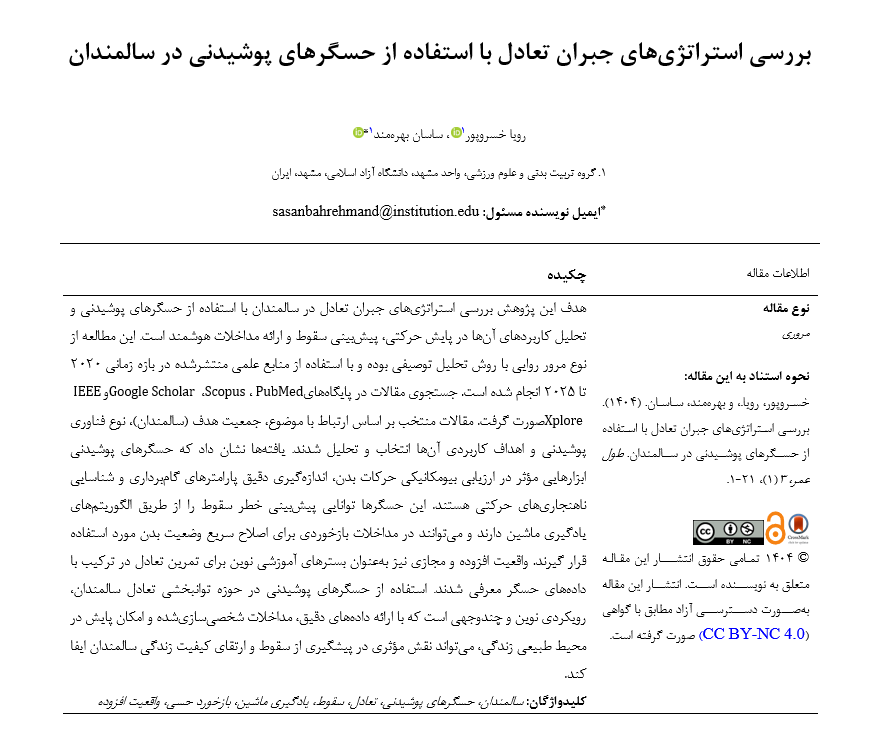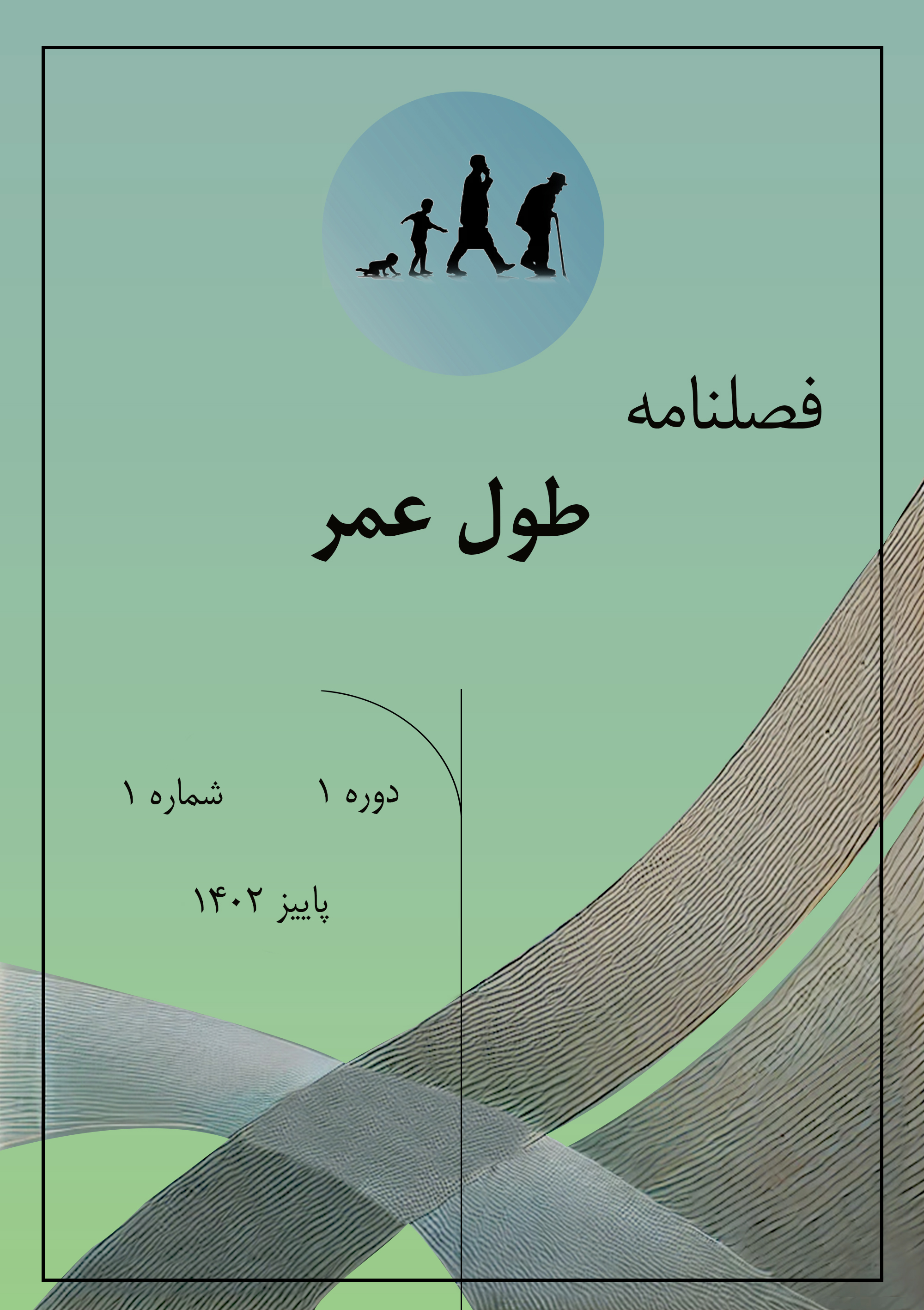A Review of Balance Compensation Strategies Using Wearable Sensors in the Elderly
Keywords:
Elderly, wearable sensors, balance, fall, machine learning, sensory feedback, augmented realityAbstract
This study aims to examine balance compensation strategies in the elderly using wearable sensors and explore their application in motion monitoring, fall prediction, and intelligent interventions. This research is a narrative review using a descriptive analysis method. Articles published between 2020 and 2025 were retrieved from PubMed, Scopus, Google Scholar, and IEEE Xplore. Eligible studies were selected based on relevance to elderly populations, wearable sensor technologies, and their practical applications in balance-related interventions. The results indicate that wearable sensors are effective tools for biomechanical assessment, precise measurement of gait parameters, and detection of abnormal movement patterns. These devices have the potential to predict fall risks through machine learning algorithms and are applied in real-time feedback systems for posture correction. Augmented and virtual reality were also identified as innovative training platforms that can be integrated with sensor data for balance rehabilitation. The application of wearable sensors in elderly balance rehabilitation represents a novel and multidimensional approach that enables personalized interventions, accurate data collection, and real-life monitoring. This technology holds significant promise in fall prevention and enhancing the quality of life for older adults.
References
Alsadoon, A., Al‐Naymat, G., & Jerew, O. D. (2024). An Architectural Framework of Elderly Healthcare Monitoring and Tracking Through Wearable Sensor Technologies. Multimedia Tools and Applications, 83(26), 67825-67870. https://doi.org/10.1007/s11042-024-18177-0
Bharti, J., Singh, M., & Singh, H. (2025). Impact of Smart Wearables on the Behavior and Attitude Among Students of Engineering and Arts Faculty. 245-264. https://doi.org/10.4018/979-8-3693-3410-2.ch011
Cahyani, K. D., Sukihananto, & Nursasi, A. Y. (2024). Effectiveness Effectiveness of Wearable Electronic Device for Fall Risk Prevention in Community Elderly: A Literature Review. Lentera Perawat, 5(2), 318-325. https://doi.org/10.52235/lp.v5i2.319
Cui, Y., Zhang, L., Hou, Y., & Tian, G. (2021). Design of Intelligent Home Pension Service Platform Based on Machine Learning and Wireless Sensor Network. Journal of Intelligent & Fuzzy Systems, 40(2), 2529-2540. https://doi.org/10.3233/jifs-189246
George, T. (2025). Medmind:Smart Medicine Management System and Emotionally Adaptive AI for Elderly Care. Interantional Journal of Scientific Research in Engineering and Management, 09(03), 1-9. https://doi.org/10.55041/ijsrem41946
Huang, M., Yang, C., & Zhang, Y. (2025). The Design Exploration of Smart Wearable Glasses for the Elderly Based on AHP-QFD. Ah, 16. https://doi.org/10.63313/ah.9001
Khin Shoon Lei Thant, Z., Kim, S., Kim, H. S., & Feyissa, I. F. (2023). A Study on Technology Acceptance of Digital Healthcare Among Older Korean Adults Using Extended Tam (Extended Technology Acceptance Model). Administrative Sciences, 13(2), 42. https://doi.org/10.3390/admsci13020042
Klavestad, S., Assres, G., Fagernes, S., & Grønli, T. M. (2020). Monitoring Activities of Daily Living Using UWB Radar Technology: A Contactless Approach. Iot, 1(2), 320-336. https://doi.org/10.3390/iot1020019
Kruse, K., Sauerwein, W., Lübben, J. F., & Dodel, R. (2024). Smart Technologies and Textiles and Their Potential Use and Application in the Care and Support of Elderly Individuals: A Systematic Review. Reviews on Advanced Materials Science, 63(1). https://doi.org/10.1515/rams-2023-0174
Liu, J. (2024). Research on the Application of Intelligent Detection Wristband Screen Projection Function for Elderly People With Blurred Eyes. Applied and Computational Engineering, 92(1), 88-94. https://doi.org/10.54254/2755-2721/92/20241715
Moreira, J. E., Bettio, R. W. d., Freire, A. P., Santos, L., & Pereira, M. R. (2024). Elderly Fall Monitoring in Smart Homes Using Wearable Device. 124-132. https://doi.org/10.5753/webmedia.2024.241629
Paschky, S. (2024). Printed Electronics Sensor Solutions for Smart Health Monitoring and Elderly Care Wearables. Ope Journal, 14(47), 20-21. https://doi.org/10.51202/2366-8040-2024-47-020
Qin, H., & Li, Q. (2024). Exploring Factors Influencing the Adoption of Smart Elderly Care Products: An Enhanced UTAUT Model Analysis of Smart Wearables. Edelweiss Applied Science and Technology, 8(5). https://doi.org/10.55214/25768484.v8i5.1796
Raveena, S. (2025). A Feasibility Study on Conductive Thread for Wearable Devices. Interantional Journal of Scientific Research in Engineering and Management, 09(04), 1-9. https://doi.org/10.55041/ijsrem45630
Shou, S. (2024). Design and Research of Smart Elderly Connected Wearable Device System. Asder, 1(2), 1. https://doi.org/10.61935/asder.2.1.2024.p1
Thanthoni, S., Kumaresan, A., Suganthirababu, P., Vishnuram, S., & Alagesan, J. (2024). Effectiveness of Sensing and Feedback Alerting Smart Cane System: An Assisted Device for Geriatric Population to Prevent Falling. Indian Journal of Physiotherapy and Occupational Therapy - An International Journal, 18, 358-362. https://doi.org/10.37506/dxdad689
Wang, I. L., Wang, L.-I., Liu, Y., Su, Y., Yao, S., & Ho, C.-S. (2021). Application of Real-Time Visual Feedback System in Balance Training of the Center of Pressure With Smart Wearable Devices. International journal of environmental research and public health, 18(18), 9637. https://doi.org/10.3390/ijerph18189637
Wang, I. L., Wang, L.-I., Xue, S.-J., Hu, R., Jian, R.-J., & Ho, C.-S. (2021). Gender Differences of the Improvement in Balance Control Based on the Real-Time Visual Feedback System With Smart Wearable Devices. Acta of Bioengineering and Biomechanics, 23(1). https://doi.org/10.37190/abb-01764-2020-02
Wang, I. L., Wang, L.-I., Xue, S.-J., Hu, R., Su, Y., Jian, R.-J., & Ho, C.-S. (2020). Improvement of Gender Balance Based on the Real-Time Visual Feedback System of the Pressure Center of Smart Wearable Devices: A Case Control Study. https://doi.org/10.21203/rs.3.rs-78823/v1
Wang, Y. (2023). Research on the Application of Smart Wearable in the Emotional Management of the Elderly. https://doi.org/10.3233/faia230789
Wen-jin, H., Tajuddin, R. M., & Shariff, S. M. (2024). Construction of Smart Clothing Service System for the Health and Well-Being of the Aging Community in a Sustainable Society. JLSDGR, 5(2), e02870. https://doi.org/10.47172/2965-730x.sdgsreview.v5.n02.pe02870
Yuguang, Z. (2021). Application of Smart Wearable Devices in the Health Management of the Elderly. Creative Economy, 5(1), 53-61. https://doi.org/10.47297/wspcewsp2516-251905.20210501
Zhang, Q., Du, Z. Z., Tian, J., & Li, J. (2025). Analysis of the Effectiveness and User Acceptance of Smart Wearable Devices in the Management of Chronic Diseases in the Elderly. Ijgpn, 3(1), 1-9. https://doi.org/10.26689/ijgpn.v3i1.9662
Zhao, Y., Chen, J. m., & Xi, N. (2023). Improving Human Balance With Wearable Devices. https://doi.org/10.12783/shm2023/36967

Downloads
Published
Submitted
Revised
Accepted
Issue
Section
License
Copyright (c) 2025 سارا محمدی زائر (نویسنده); زهرا انجم شعاع; سنجر سلاجقه (نویسنده)

This work is licensed under a Creative Commons Attribution-NonCommercial 4.0 International License.









